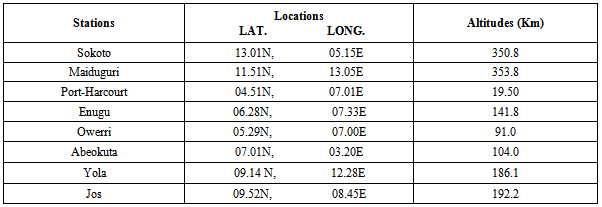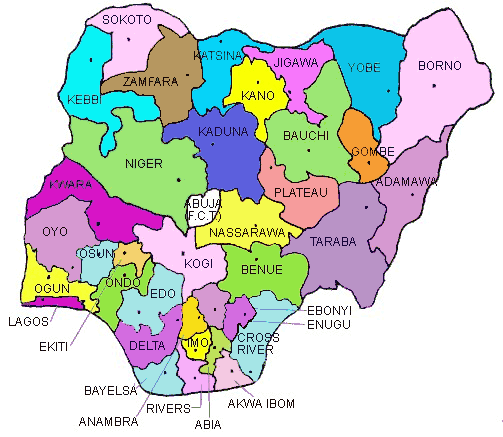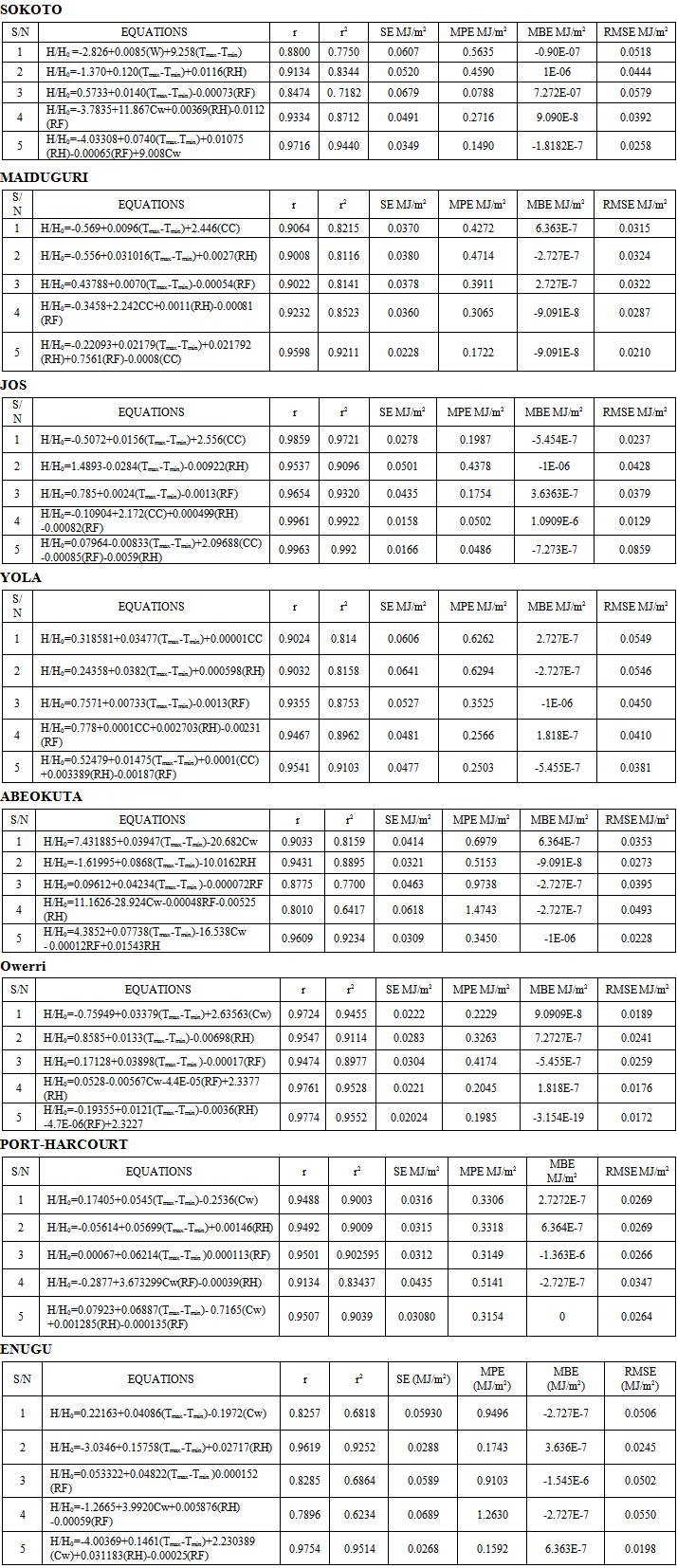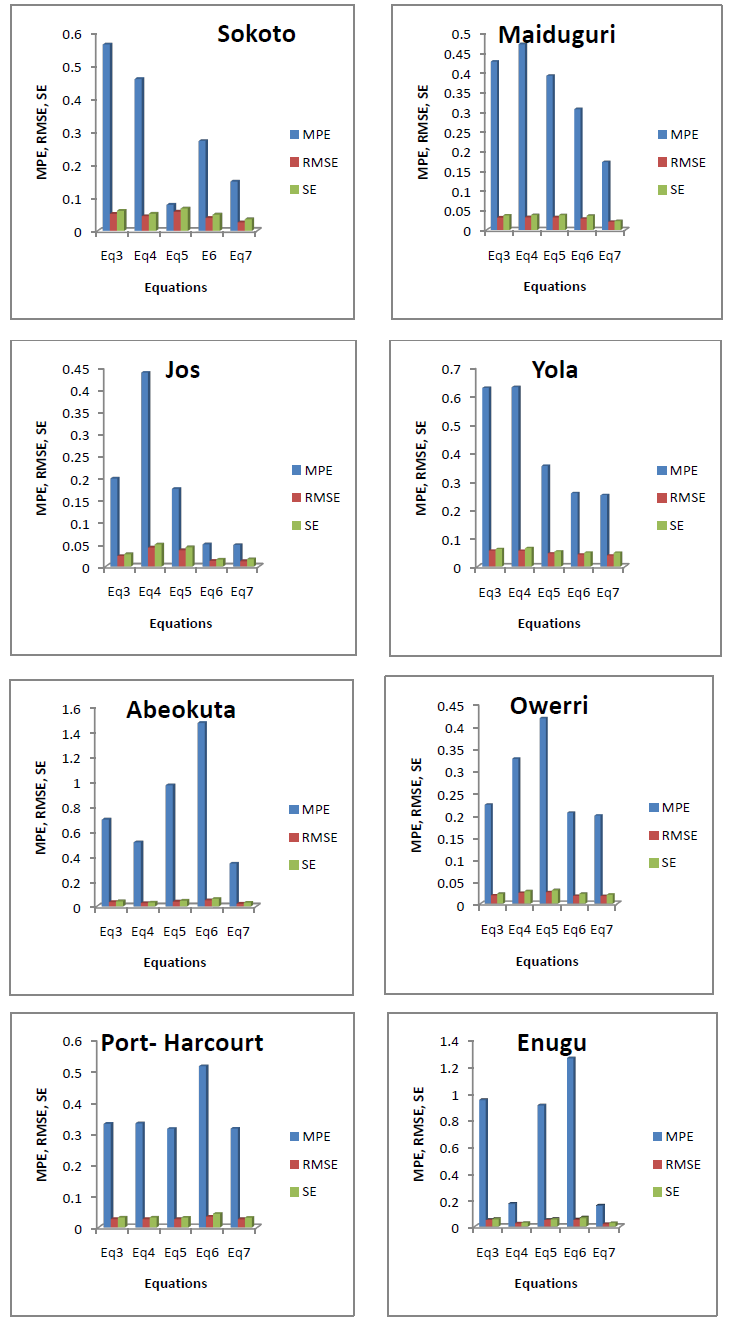Falayi E. O.
Department of Physics, Tai Solarin University of Education, Ijagun, Ijebu Ode, Nigeria
Correspondence to: Falayi E. O., Department of Physics, Tai Solarin University of Education, Ijagun, Ijebu Ode, Nigeria.
| Email: |  |
Copyright © 2012 Scientific & Academic Publishing. All Rights Reserved.
Abstract
This study examines the impact of cloud cover, relative humidity, rainfall and the daily values of global solar radiation at eight locations in Nigeria, using different proposed empirical models for 16 years (1995-2010). The accuracy of the proposed models was tested using statistical indicators; RMSE (Root Mean Square Error), MBE (Mean Bias Error), Standard Error (SE), MPE (Mean Percentage Error) and Correlation Coefficient (r). The Equation with high value of correlation coefficient and low values of MPE, MBE, RMSE and SE is considered as the best Equation (Eqs.7). It was observed that the new model can be used for estimating daily values of global solar radiation with a higher accuracy and has good adaptability to highly variable weather conditions.
Keywords:
Solar Radiation, Meteorological Parameters, Statistical Indicators
Cite this paper: Falayi E. O., The Impact of Cloud Cover, Relative Humidity, Temperature and Rainfall on Solar Radiation in Nigeria, Energy and Power, Vol. 3 No. 6, 2013, pp. 119-127. doi: 10.5923/j.ep.20130306.03.
1. Introduction
The quantity of solar radiation reaching the Earth’s surface varies dramatically as a function of changing atmospheric conditions as well as the changing position of the Sun through the day. Accurate data of global solar radiation are necessary at various steps of the design, simulation, and performance evaluation of any project involving solar energy. The solar radiation modelling has shown significant progress in recent decades, reaching at present integration in geographic information systems that allow quantification at its spatial distribution, also provide detailed estimates or forecast climate changes which have improved significantly in recent years. Several models have been proposed for generation of global radiation. The random nature of global solar radiation is included in all proposals, but the way of implementing this in a model varies significantly[1-6].Meteorological parameters such as cloud cover, relative humidity, rainfall and temperature play an important role in the radiative energy budget of the Earth and in the transfer of energy between the surface and the atmosphere.[7 and 8] proposed solar radiation estimation using differences between maximum and minimum ambient temperature. Some studies were based on hourly solar radiation prediction using different meteorological parameters and the methods are claimed to perform well[9-21]. Meteorological parameters are frequently used as predictors of atmospheric parameters since acquiring detail atmospheric conditions require advance measurement. Meteorological parameters have been used to estimate atmospheric transmittance coefficient in parametric model. This kind of model is called meteorological mode.[22] predicted the daily global solar radiation of Amman city in Jordan on a horizontal oriented surface using four models, including a sine wave model. Statistical results showed that the sine wave model gave best fit.[23] used a cosine wave model to calculate the daily global solar radiation in six climatic zones of Greece and the correlation coefficient for all cases is higher than 0.996.In this paper, different models were used to estimate the global solar radiation using cloud cover, rainfall, relative humidity, maximum and minimum temperature difference. The purpose of using different models is to identify the most appropriate models for the estimation of global solar radiation.
2. Data
Daily measured global solar radiation (H), cloud cover (CC), rainfall (RF) and relative humidity (RH) data for 16 years (1995-2010) listed in Table 1 and displayed in Figure 1, for 8 meteorological stations covering some selected cities in Nigeria, taken from Archives of Nigerian meteorological Agency Oshodi, Lagos State. These sites are located widely throughout Nigeria, they are considered as representative of different climatic regions in Nigeria.Data AnalysisDaily solar radiation is a quasi-periodic phenomenon on a yearly cycle due to seasonal effects. Trigonometric correlations give good fitting among the models for predicting daily global solar radiation by the day of the year. | (1) |
Where Ho = monthly mean daily extraterrestrial radiation MJ/m2Gsc = Solar constant = 1367 W/m2 | (2) |
θ = Latitude angle for the location in degreesδ = declination angle for the month in degreen = mean day of each monthsTable 1. Geographical location of the stations
 |
| |
|
 | Figure 1. The Map of Nigeria showing the stations used |
The correlations to which the measured data were fitted are as follows: | (3) |
 | (4) |
 | (5) |
 | (6) |
 | (7) |
Where a, b, c, d and e are empirical constants. The measured data were used in multiple linear regression analysis to obtain the values of empirical constants in Eqs. (3) – (7).Monthly mean of cloud cover, rainfall and relative humidity (1995-2010) varied both spatially and seasonally in Nigeria. The weather regimes often change significantly during each of the conventional two seasons. The monthly available amount of solar energy at these latitudes depends on the contributions of wet (May -October) season during the same period, southern Nigeria begins its rainy season which is the reason why global solar radiation are at their lowest in Port-Harcourt, Abeokuta and Owerri and reverse is the case for high global solar radiation in dry seasons (November- April) in Sokoto, Maiduguri, Yola and Jos. It was noticed that the rainfall is intense between the months of June and August (see Figure 2). Contour plots of monthly spatial distribution of global radiation for Nigeria reveals a strong influence of latitude and the monthly course in the cloud cover on the incoming solar radiation patterns. It has been observed in the distribution of the monthly amounts of global solar radiation, which may be due to differences in the atmospheric circulation. Cloud cover, rainfall and relative humidity are the most important atmospheric phenomena limiting solar radiation at the Earth surface. It was noted that the cloud cover influences the clear days, decreasing cloud cover will lead to an increase in the number of clear days.In the month of April to October there are high values of cloud cover, high rainfall and high percentage of relative humidity was observed between the latitude of 4.51 and 7.01. This meteorological parameters used in this research reduce the availability sunshine duration when the solar elevation is high. This implies that there was high proportion of cloudy days and relative to low solar energy between April and October of 1995-2010 and relative abundant of solar energy between November and March of 1995-2010 in Nigeria. It was also observed that the regions with higher cloud density (for example humid regions) receive less solar radiation than the cloud-free climates (for example deserts). For any given location, solar radiation reaching the Earth’s surface decreases with increasing cloud cover. | Figure 2. Monthly mean cloud cover, rainfall and relative humidity for Nigeria, 1995-2010 |
Table 2. Shows equation with regression and statistical indicators across the eight stations
 |
| |
|
The accuracy of the estimated values was tested by calculating the RMSE (Root Mean square Error), MBE (Mean Bias Error), MPE (Mean Percentage Error) and SE (Standard Error). The RMSE (MJ/m2), MBE (MJ/m2), MPE (%) and SE MJ/m2 for the 5 models.
3. Discussion of Result
The performance of the above five models, Eqs. (3)–(7), are evaluated at eight meteorological stations over Nigeria, namely Sokoto, Jos, Maiduguri, Yola, Abeokuta, Owerri, Port-Harcourt and Enugu which represent geographical and climatic conditions of their regions. According to MPE, MBE, RMSE and r, r2 and SE as shown in Table 1, the proposed model, Eq. (7), has the best accuracy based on the measured data at eight stations, with the MPE (MJ/m2), MBE (MJ/m2), RMSE (MJ/m2) and SE (MJ/m2) vary from one model to another model.The monthly variations are most strongly correlated with cloudiness. Generally, correlation coefficients (0.8257 - 0.9963) are high for across the stations. This implies that, there are statistically significant relationships between the clearness index, cloud cover, the relative humidity, difference between maximum to minimum daily temperature and rainfall, this is further demonstrated by high values of coefficient of determination R2 (0.6828 - 0.9920) across the eight stations. The MBE obtained positive values and negative values across the stations. This shows that the models vary between over and under estimation of H.The relative performance of the five models at eight stations is that the Eq. (7) is the best equation. So, for Nigeria, the daily global solar radiation can be estimated by the proposed model with better accuracy. The accuracy of the predicted data is tested and model performance was evaluated using the root mean square error (RMSE), the mean bias error (MBE) and mean percentage error (MPE). The RMSE, MBE and MPE are mostly used methods for the comparison and performance estimation of the solar irradiation models. These calculated statistical indicators concerning the global, direct and diffuse radiations are very good. For most of the equations, the best performance, based on MPE, MBE, RMSE and SE is achieved by Eq. (7). The errors resulting from Eqs. (3) - (7), for the eight stations are such that the MPE, MBE, RMSE and SE lies between 0.149- 1.474 MJ/m2, -9.09091E-08 - 1.09091E- 06MJ/m2, 0.012227- 0.054997MJ/m2 and 0.01575 - 0.06894 MJ/m2 respectively. From the Table 2, the negative values of the MBE are under-estimate, while RMSE slightly over-estimate. In all cases, the absolute values of the MPE never reach 1.48%, indicating very good agreement between the measured and calculated data and a good fitting exists between the monthly average of daily global solar radiation and the other meteorological parameters used. It was noted that the estimation result is either overestimating the solar radiation or underestimating the solar radiation. This may be as a result of the cloudy sky which sometimes appear or disappears. The mean bias errors are expected to be small because the sunny and cloudy periods will average out while the significant difference between a sunny and cloudy period will lead to large standard deviations between different time intervals. Also[24] established the overestimation which could be due to the increased reflection of solar radiation from snow cover or a decreasing role of atmospheric scattering due to lower solar declination angles. Figure 2, shows that there is greater availability of solar radiation in Sokoto, Maiduguri, Yola and Jos than Abeokuta, Enugu, Owerri and Port-Harcourt. The wet season minimum is expected due to poor sky conditions caused by atmospheric controls as the atmosphere is partly cloudy and part of solar radiation are scattered by air molecules. Increased cloud cover is as a result of the low value of clearness index and temperature in the wet season, with high values of rainfall and relative humidity has contributed to the decrease in clear days in the stations under analysis. Contour plots of monthly spatial distribution of global radiation for the eight locations reveal a strong influence of latitude and the monthly course in the cloud cover on the incoming solar radiation patterns. Clearness indices are higher in dry than in wet seasons for all stations. This implies that the cloud cover and relative humidity are higher in wet than in dry. More rainfall was recorded in Abeokuta, Enugu, Owerri and Port-Harcourt, between the month of May and October, with low surface temperature, high relative humidity and low cloud cover.It was noticed from figure 3, the lower the RMSE, MPE and SE the more accurate the equation. This indicates that Eq. (7) is most suitable for the estimation of monthly average daily global radiation based on statistical analysis.  | Figure 3. Comparison between the MPE, RSME and SE of Eqs. (3)– (7), at eight stations in Nigeria |
4. Conclusions
The global solar radiation can be adequately estimated using different proposed models using daily recorded meteorological variables of maximum and minimum temperature difference, relative humidity, cloud cover and rainfall. In order to obtain some accurate solar radiation estimations, it requires accurate mathematical modelling of all the climatological parameters. From figure 2, there is high proportion of cloudy days, relative to low solar energy with low temperature in the wet season while low cloudy day with high solar energy and high temperature in dry season across the latitudes. It was observed that Eq. (7) has the highest value of correlation coefficient and correlation of determination, which gives good results when considering statistical indicators, RMSE, MBE, SE, MPE and correlation coefficient (r). It is found that the new model can be used for estimating daily values of global solar radiation with a higher accuracy and has good adaptability to highly variable weather conditions. The estimated value of global solar radiation reveals that solar radiation can be efficiently used to compensate for energy inadequacy.
ACKNOWLEDGEMENTS
The author wish to acknowledge the management of the Nigeria Meteorological Agency, Oshodi, Lagos State, for making the data of global solar radiation, surface temperatures, relative humidity, cloud cover and rainfall available.
References
| [1] | Ångström A. 1924. Solar and terrestrial radiation. Quart J Roy Meteorol Soc; 50 (210):121–125. |
| [2] | Erbs D.G, Klein S.A, and Duffie JA. 1982. Estimation of the diffuse radiation fraction for hourly, daily and monthly average global radiation. Sol Energy, 28:293–302. |
| [3] | Falayi, E.O. and A.B. Rabiu, 2005. Modelling global solar radiation using sunshine duration data. Nigeria J. Phys., 17S: 181-186. |
| [4] | Falayi, E.O., J.O. Adepitan, and A.B. Rabiu. 2008. Empirical models for the correlation of global solar radiation with meteorological data for Iseyin, Nigeria. International Journal of Physical Sciences 3(9):210-216. |
| [5] | Falayi, E.O, Rabiu, A.B and Teliat, R.O. 2011. Correlations to estimate monthly mean of daily diffuse solar radiation in some selected cities in Nigeria. Advances in Applied Science Research, 2 (4):480-490. |
| [6] | Trabea, A.A. and M.A. Shaltout. 2000. Correlation of global solar-radiation with meteorological parameters over Egypt. Renew. Energy, 21: 297-308. |
| [7] | Bristow K. L, and Campbell G.S. On the relationship between incoming solar radiation and daily maximum and minimum temperature. 1984. Agric Forest Meteorology; 31(2):159–66. |
| [8] | Hargreaves G.H and Samani Z.A.1982. Estimating potential evapotranspiration. J Irrig. Drain Div; 108 (3):225–30. |
| [9] | Liu and Jordan. 1960. The interrelationship and characteristic distribution of direct, diffuse and total solar radiation. Sol Energy, 4, (3) l–19. |
| [10] | Hunt LA, Kuchar L, and Swanton CJ.1998. Estimation of solar radiation for use in crop modelling. Agric. Forest Meteorol. 91(3–4):293–300 |
| [11] | Zhou Jin, Wu Yezheng and Yan Gang. 2004. Estimation of daily diffuse solar radiation in China. Renewable Energy 29, 1537–1548. |
| [12] | Graham, V and Hollands, K., 1990. A method to generate synthetic hourly solar radiation globally. Int. J. Solar Energy 44, 333–341. |
| [13] | Hassan A.N Hejase and Ali H Assi.2011. Time series regression model for prediction of monthly and daily average global solar radiation Al Ain City-UAE. Proceedings of the global conference warming, 11-14, Lisbon, Portugal. |
| [14] | Dimas Firmanda Al Riza, Syed Ihtsham ul Haq Gilani and Mohd. Shiraz Aris.2011 Hourly Solar radiation estimation using ambient temperature and relative humidity data International Journal of Environmental Science and Development, Vol. 2, No. 3. |
| [15] | Falayi, E.O and A.B. Rabiu, 2011. Estimation of global solar radiation using cloud cover and surface temperature in some selected cities in Nigeria. Archives of Physics Research, 2(3):99-109. |
| [16] | Hargreaves, G. H. and Z. A. Samani 1985. Reference crop evapotranspiration from temperature. Appl. Eng. Agric. 1:96–99. |
| [17] | Liu X.Y, Mei X.R, Li Y.Z, Wang Q.S, Jensen J.R, Zhang Y.Q and Porter J.R. 2009 Evaluation of temperature-based global solar radiation models in China. Agric Forest Meteorology; 149 (9):1433–46. |
| [18] | Badescu V. 2002. A new kind of cloudy sky model to compute instantaneous values of diffuse and global solar irradiance. Theory Appl Climatology; 72 (1–2): 127–36. |
| [19] | Gul M, Muneer T, Kambezidis H. 1998. Models for obtaining solar radiation from other meteorological data. Sol Energy; 64 (1–3):99–108. |
| [20] | Hamdy, K. Elminir. 2007. Experimental and theoretical investigation of diffuse solar radiation: Data and models quality tested for Egyptian sites. Energy; 32, 73–82. |
| [21] | Falayi, E.O and A.B. Rabiu, 2012. Solar radiation and information for renewable energy application. Published by In Tech, Solar radiation Edited by Elisha. Babatunde. Page 111-130. |
| [22] | Al-Salaymeh A. 2006. Model for the prediction of global daily solar radiation on horizontal surfaces for Amman city. Emirates J Eng Res; 11 (1):49–56. |
| [23] | Kaplanis S and Kaplani E.2007. A model to predict expected mean and stochastic hourly global solar radiation I(h; nj) values. Renew Energy; 32 (8):1414–25. |
| [24] | Spokas, K.A., Forcella, F. 2006. Estimating hourly incoming solar radiation from Limited meteorological data. Weed Science. 54:182-189. |











 Abstract
Abstract Reference
Reference Full-Text PDF
Full-Text PDF Full-text HTML
Full-text HTML
